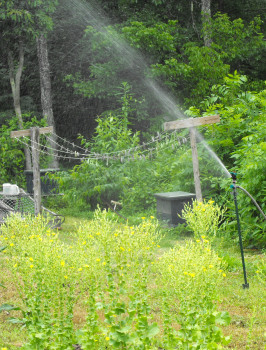
Introduction to a farm irrigation system
 Our
part of the central Appalachian mountains is nearly a temperate
rainforest, with about 40 inches of rainfall scattered evenly
throughout the
average year. Unfortunately, our first two years on the farm
coincided with drought conditions, and I saw firsthand what happens
when plants don't get enough water --- they just stop growing. Berries
are especially sensitive to lack of water, with
experts recommending that they get at least an inch of water per
week.
That's an inch as measured in a rain gauge, which should penetrate to
about 6 to 12 inches into your soil.
Our
part of the central Appalachian mountains is nearly a temperate
rainforest, with about 40 inches of rainfall scattered evenly
throughout the
average year. Unfortunately, our first two years on the farm
coincided with drought conditions, and I saw firsthand what happens
when plants don't get enough water --- they just stop growing. Berries
are especially sensitive to lack of water, with
experts recommending that they get at least an inch of water per
week.
That's an inch as measured in a rain gauge, which should penetrate to
about 6 to 12 inches into your soil.
The drought prompted us to start experimenting with the most cost and
time effective
way to get water to our plants. This week's lunchtime
series runs through our attempts at irrigation --- both the failures
and the successes. Our situation is a bit
unique, so
you should consider your own conditions before putting our suggestions
into practice. Specifically, we are lucky to have copious water
available even during the worst droughts since we have a creek which
runs along the edge of our property --- no need to pay through the nose
for city water and carefully preserve every drop. On the other
hand, the slight turbidity (muddiness) of our creek water makes some
irrigation systems fail which would work well for city-dwellers.
I'd be very curious to hear how my experiences have differed from yours
if you've also embarked on the irrigation journey.
| This post is part of our Irrigation lunchtime series.
Read all of the entries: |
Want more in-depth information? Browse through our books.
Or explore more posts by date or by subject.
About us: Anna Hess and Mark Hamilton spent over a decade living self-sufficiently in the mountains of Virginia before moving north to start over from scratch in the foothills of Ohio. They've experimented with permaculture, no-till gardening, trailersteading, home-based microbusinesses and much more, writing about their adventures in both blogs and books.
Want to be notified when new comments are posted on this page? Click on the RSS button after you add a comment to subscribe to the comment feed, or simply check the box beside "email replies to me" while writing your comment.
- Remove comment
- Remove comment
